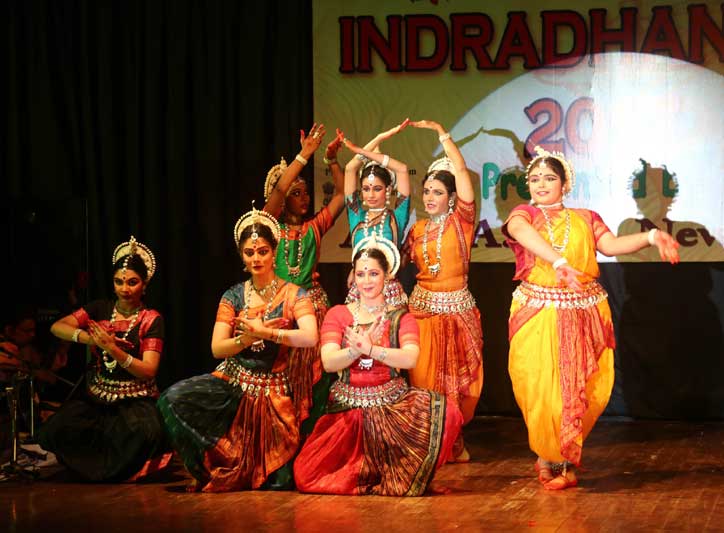 New Delhi:
New Delhi: INDRADHANUSH 2017 was organised by Association for Learning Performing Arts and Normative Action (ALPANA) At Azad Bhavan Auditorium, Indian Council for Cultural Relations (ICCR), New Delhi on 29 May 2017. ALPANA was launched in 2004 as a registered Society in the National Capital Territory of Delhi.
In a short span of its coming into being, ALPANA has made significant contribution to its espoused cause of spreading awareness among today’s youth about the rich cultural heritage of India, especially Odissi Dance, Vocal and Instrumental Music.
The 14th Annual Event INDRADHANUSH 2017 was a kaleidoscope of different dance and music items presented by the little wonders, budding classical dancers, senior disciples of Guru Smt Alpana Nayak and singers and special students of A.L.P.A.N.A. As the rainbow with its vibrant colours fills the heart of the beholder with joy and pleasure, our artists mesmerized the audience with different varieties of dance and music.

The event was designed to be a unique demonstration of the ‘will to succeed together’ where special students and other students performed together on the same stage.
Dr. Amarendra Khatua, IFS, Secretary to the Government of India, Ministry of External Affairs and Director General of ICCR was the Chief Guest and Dr. Arun Kumar Verma, IFS, Joint Secretary, Ministry of Power, Govt. of India and Dr. Sangita Gosain, Chief Executive of Guru Kelu Charan Mohapatra Odissi Research Centre, Bhubaneswar, Odisha were the Distinguished Guests of the event. After the lighting of the ceremonial lamp by the guests the performances started.
At the outset talented singers, keyboard players, Tabla players and flutist presented Chhota Khayaal based on Raag: Patdeep, Tagore song – Sajani sajani...... and a (Bengali Baul) “Tomai Rid Maajhere Raakhibo Chhede Debo jaa............”
The highlight of the evening cultural programme is a dance based on a popular Hindi Film song “Tu hai aasman me teri ye zameen hai.......” presented by the Divyaang students of ALPANA.

Special students of ALPANA are no less than anybody else in terms of talents. They presented a fusion dance based on a popular Hindi Film song “Taal se taal mila....” and Odissi dance.
The little talented Odissi dancers of ALPANA started with a popular song “Eka Dantaay Vakra Tundaay.....” sung by famous playback singer Shankar Mahadevan. It is a prayer to Lord Ganesha, the destroyer of all obstacles, the God of Wisdom and the God of Dance.
The next item was “Shiva Tandava” written by Ravana, the demon king of Lanka in which the “Udhata or Rudra” manifestation of Lord Shiva is depicted.
The next item was “Kalyan Pallavi”. The word “Pallavi” has been derived from the Sanskrit word pallava, which means the bud of a leaf, or the shoots of a tree which are very tender. The movements in this item were extremely graceful and lyrical. Pallavi was based on “Kalyan Raga”.
The next item was an Abhinaya based on a very popular Odia devotional song “Ahe Nila Shaila Prabala Matta Barana………….” written by 17th century Devotional poet Salabega. An ardent devotee of Lord Jagannath, the poet prays to the Lord to save him from sufferings as He had come to the rescue of the elephant attacked by the crocodile and Draupadi whose honour was at stake in the Kaurava’s court. It is written in such a simple style that any reader would find it very evocative.

In order to beautify the dance composition and also to dramatise the inherent theme, a lot of Sancharis has been used. Sanchari in Classical dances is a choreographic technique in which the same idea or meaning is expressed in a variety of ways.
The next item was “Khamaaj Pallavi” on Raag: Khamaaj and Taal:Jhampa Taal
The Last item for the evening was a special choreography “Bhoomi Mangalam” along with Moksha in which the dancers will pray for salvation. Moksha means “spiritual liberation”. This dance represents a spiritual culmination for the dancer who soars into the realm of pure aesthetic delight.
The dance moves onto a crescendo that is thrilling to both, the eye and the ear. With the cosmic sound of the “Om”, the dance dissolves into nothingness — just like Moksha or the deliverance of the soul in real life. This was choreographed by Guru Smt Alpana Nayak and music was composed by Shri Prasanta Behera and Shri Prafulla Mangaraj.

At the end Dr. Arun Kumar Verma and Dr. Sangita Gosain honoured Guru Smt Alpana Nayak, other teachers and accompanying musicians with bouquet and distributed prizes to winning students. Then Dr Verma said that despite the global influences, today’s children have been taking keen interest in traditional art forms of India. We must give them support and encouragement.
He also appreciated Smt. Alpana Nayak’s efforts for inculcating cultural values in the youth and promoting it further.
He blessed the children with lots of good wishes to do good in future. Dr Sangita Gosain appreciated A.L.P.A.N.A.NGO’s efforts to popularise Classical Dance and Music amongst the new generation of India, specially Odissi Dance.
 New Delhi: INDRADHANUSH 2017 was organised by Association for Learning Performing Arts and Normative Action (ALPANA) At Azad Bhavan Auditorium, Indian Council for Cultural Relations (ICCR), New Delhi on 29 May 2017. ALPANA was launched in 2004 as a registered Society in the National Capital Territory of Delhi.
New Delhi: INDRADHANUSH 2017 was organised by Association for Learning Performing Arts and Normative Action (ALPANA) At Azad Bhavan Auditorium, Indian Council for Cultural Relations (ICCR), New Delhi on 29 May 2017. ALPANA was launched in 2004 as a registered Society in the National Capital Territory of Delhi. 



